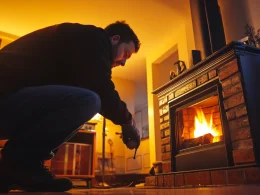Have you ever been annoyed by a light that keeps blinking? I know I have.
Flickering lights can be more than a bother—they might point to bigger issues in your home’s electrical system.
But don’t worry, I’ve got you covered.
In this post, I’ll walk you through 10 common reasons why your lights might be flickering and how to fix them.
We’ll explore the culprits behind this pesky problem, from loose bulbs to faulty wiring.
By the end, you’ll have the know-how to tackle flickering lights and bring steady illumination back to your home.
Are you ready to shed some light on those flickering fixtures? Let’s get started!
Why Do the Light Flicker? How You Should Respond to It?
Flickering lights can be more than just an annoyance – they’re often a sign that something’s not quite right with your lighting or electrical system.
But why exactly do lights flicker? Let’s shed some light on this common issue.
At its core, flickering happens when there’s an inconsistent flow of electricity to your light fixture.
1. Loose Bulb

A loose bulb is a common culprit behind flickering lights.
When a bulb isn’t securely screwed into its socket, it can create an unstable connection with the power source.
- Intermittent contact: As the bulb moves slightly, it may briefly disconnect and reconnect with the socket.
- Vibration effects: Even minor vibrations from footsteps or closing doors can disturb a loose bulb, causing flickering.
- Thermal expansion: As the bulb heats up and cools down, it can slightly change shape, affecting its connection if it’s already loose.
Solutions
- Turn off the light and let it cool down completely.
- Gently but firmly tighten the bulb in its socket.
- Be careful not to over-tighten, which could damage the socket or bulb.
- If tightening doesn’t work, try cleaning the bulb’s base and the socket with a dry cloth to remove dust or debris.
- For frequently jostled fixtures, consider using a bulb with a rougher surface for better grip.
- If the problem persists, the socket itself might be worn. In this case, replacing the fixture or having an electrician check it might be necessary.
This issue is often more noticeable in fixtures that are frequently jostled or in areas with a lot of foot traffic.
It’s usually an easy fix, but if left unaddressed, it can lead to more serious electrical problems over time.
2. Faulty Switch

A faulty light switch can be another source of flickering lights.
As switches age or get damaged, their internal mechanisms can wear out, leading to unreliable connections.
- Worn contacts: The metal contacts inside the switch can erode, creating inconsistent connections when you flip the switch.
- Loose wiring: The wires connected to the switch may become loose over time, causing intermittent power flow.
- Damaged mechanism: The switch’s internal spring mechanism can weaken, leading to incomplete connections even when the switch is fully on.
Solutions
- First, make sure the switch is getting proper power.
- Try resetting your circuit breaker.
- If you’re comfortable and know how to do it safely, remove the switch plate, check for loose wire connections, and tighten them if needed.
- Test the switch by turning it on and off several times; if it feels loose or doesn’t make a solid ‘click’, it’s likely worn out.
- For a worn-out switch, replacement is usually the best option.
- While it’s not a complex job, it’s best to call a professional electrician if you’re not confident in your electrical skills.
- If you notice any signs of burning, sparking, or unusual heat from the switch, turn off the power at the circuit breaker immediately and call an electrician.
When a switch is faulty, it might not complete the circuit properly every time it’s flipped.
This can result in rapid connecting and disconnecting, which appears as flickering to our eyes.
While a faulty switch might seem minor, it can lead to overheating or electrical arcing if left unaddressed.
3. Voltage Fluctuations
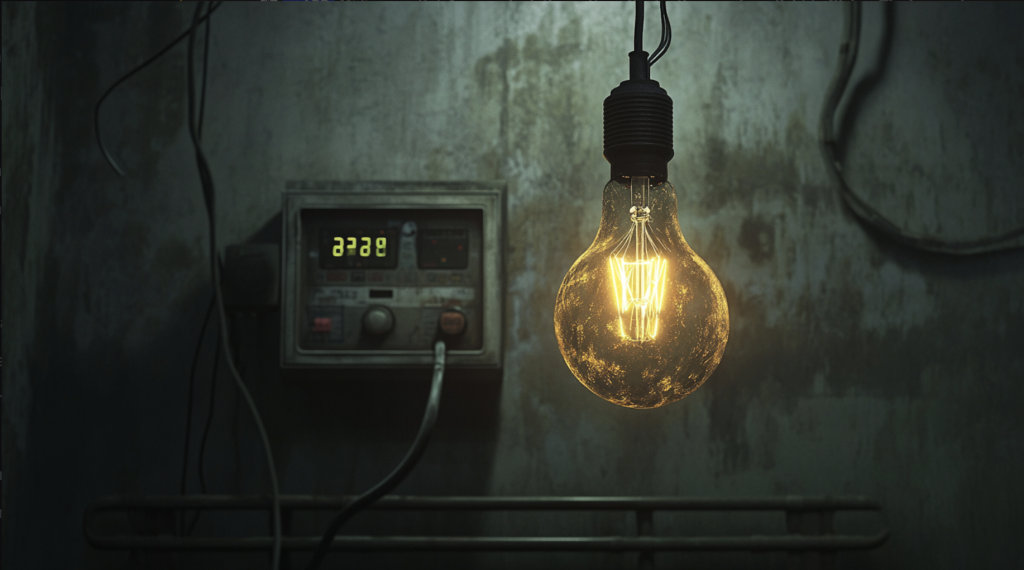
Voltage fluctuations are like waves in your home’s electrical ocean.
When large appliances turn on or off, they can create ripples that affect your lights.
This is particularly common with power-hungry devices like air conditioners, refrigerators, or washing machines.
- Sudden power draw: When a large appliance starts up, it can briefly pull voltage away from other circuits, causing lights to dim or flicker.
- Electrical noise: Some appliances can create electrical interference that disrupts the steady flow of current to your lights.
- Overloaded circuits: If your circuit is near capacity, additional load from appliances can cause noticeable voltage dips.
Solutions
- Install a voltage stabilizer to regulate the power supply to your home.
- Upgrade your electrical panel if it’s outdated or undersized for your home’s needs.
- Distribute high-power appliances across different circuits to balance the load.
- Use surge protectors for sensitive electronics to guard against sudden voltage spikes.
- If the problem is widespread, contact your utility company to check for issues with the main power supply.
If you notice your lights flickering when certain appliances kick in, it might be time to have an electrician check your home’s electrical capacity and balance.
4. Wiring Issues
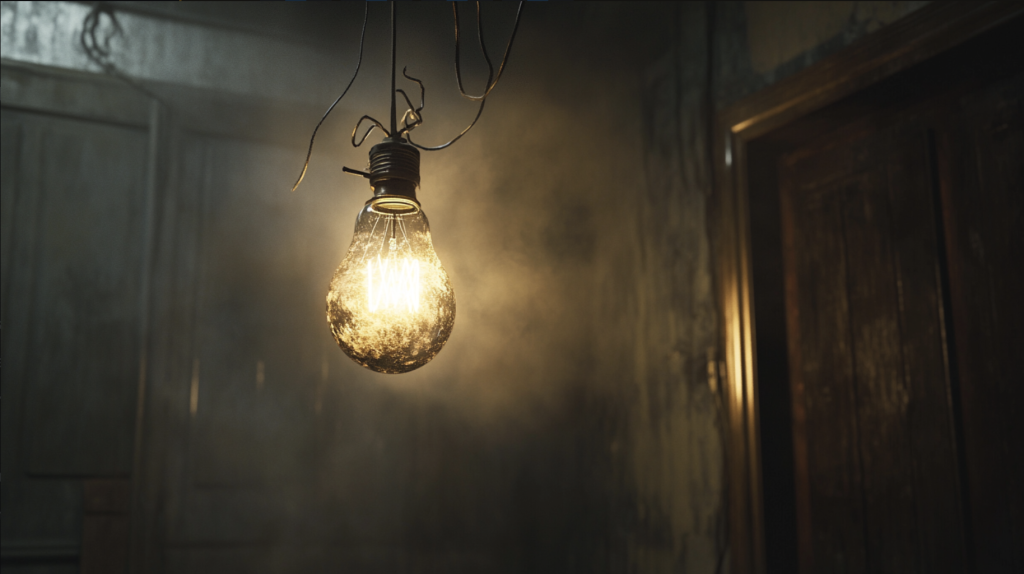
Your home’s wiring is like its nervous system; any disruption can lead to flickering lights.
Loose or frayed wires are common culprits, especially in older homes or those with DIY electrical work.
- Intermittent connections: Loose wires can make and break contact, causing lights to flicker on and off rapidly.
- Resistance hotspots: Frayed wires create high resistance points, leading to voltage drops and dimming.
- Arc faults: Damaged wires can create small electrical arcs, causing brief but noticeable flickers.
Solutions
- Schedule a professional inspection of your home’s wiring, especially if your house is older.
- Replace any visibly damaged or frayed wires immediately.
- Tighten loose connections in outlets, switches, and junction boxes.
- Update old wiring that doesn’t meet current safety standards.
- Install GFCI (Ground Fault Circuit Interrupter) outlets to prevent electrical shocks in moisture-prone areas.
Remember, wiring problems aren’t just annoying – they can be dangerous, too.
If you suspect wiring issues, it’s best to call in a professional electrician.
They can safely inspect and repair any problems, keeping your lights steady and your home safe.
5. Incompatible Bulb

Not all light bulbs are created equal, and using the wrong type can lead to flickering issues.
This is particularly common with newer LED bulbs and older dimmer switches.
- Electrical mismatch: Some bulbs require different power levels than what the fixture or dimmer provides.
- Dimmer incompatibility: Older dimmers may not work properly with energy-efficient LED bulbs.
- Wattage issues: Using a bulb with too high or low wattage for the fixture can cause instability.
Solutions
- Check the fixture’s wattage and type requirements, then replace the bulb with one that matches.
- Ensure you’re using dimmable LEDs for LED bulbs flickering on dimmer switches.
- Consider upgrading to a newer model designed for LED compatibility if using an older dimmer.
- Try a different bulb brand – some are more compatible with certain fixtures than others.
- If problems persist, consult an electrician to check if your fixture needs updating.
Always check the fixture’s requirements and the bulb’s specifications to ensure compatibility.
Upgrading to a compatible dimmer switch or choosing the right bulb type can often resolve flickering caused by incompatibility.
6. Loose or Damaged Plug

A secure connection between your lamp and the power outlet is crucial for steady illumination.
When this connection is compromised, flickering can occur.
- Poor contact: A loose plug may not maintain consistent contact with the outlet’s prongs.
- Damaged prongs: The bent or broken prongs on the plug can’t create a solid connection.
- Worn-out outlets: Old or loose outlets may not grip the plug tightly, causing intermittent power flow.
Solutions
- Unplug the device and inspect the plug for any visible damage or bent prongs.
- If the plug looks okay, try inserting it into a different outlet to see if the problem is with it.
- For a loose plug, you can try gently bending the prongs outward slightly to create a tighter fit.
- If the cord or plug is damaged, replace the entire cord or have it repaired by a professional.
- If the outlet seems to be the issue, have an electrician inspect it and potentially replace it.
Inspect your plugs regularly for signs of wear or damage.
If you notice any issues, replace the plug or the entire cord.
If problematic outlets are present, consider having them replaced by a professional electrician to ensure a safe and stable power supply.
7. Overloaded Circuit
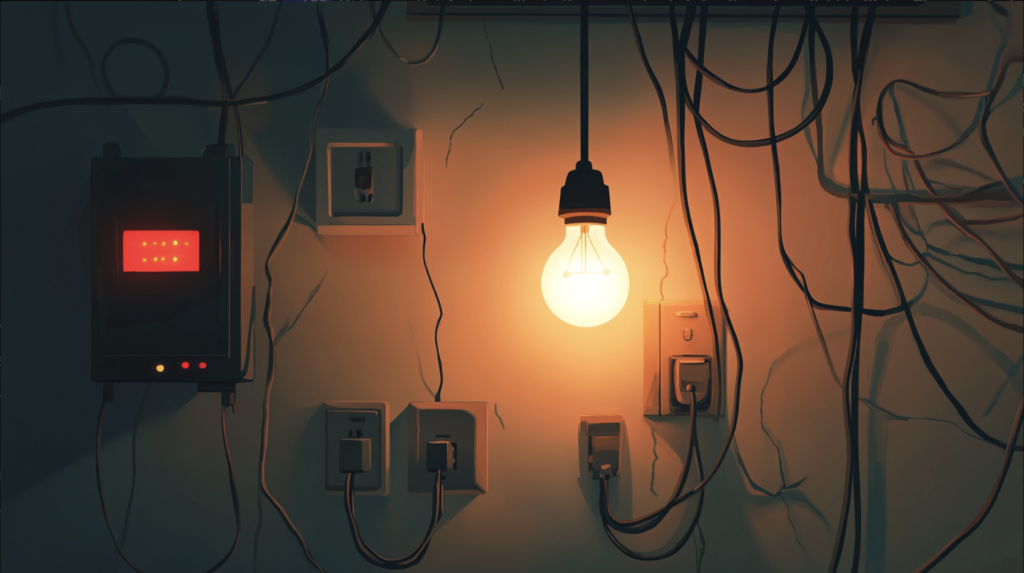
An overloaded circuit is like squeezing too much water through a narrow pipe.
When too many appliances draw power from the same circuit, temporary power dips can occur, leading to flickering lights.
- Power demand exceeds capacity: Voltage drops occur when the total power draw surpasses what the circuit can handle.
- Intermittent dimming: As high-power devices cycle on and off, they cause brief voltage fluctuations.
- Circuit breaker stress: Constant overloading can cause circuit breakers to heat up and partially trip, leading to unstable power flow.
Solutions
- Unplug some devices from the affected circuit to reduce the load.
- Spread high-wattage appliances across different circuits in your home.
- Use a wattage meter to check how much power each device is drawing.
- Consider upgrading to energy-efficient appliances to reduce overall power consumption.
- If the problem persists, have an electrician add new circuits or upgrade your electrical panel.
If you notice lights dimming when you turn on certain appliances, you might have an overloaded circuit.
This isn’t just annoying – it can be a fire hazard if left unchecked.
8. Dirty Sockets
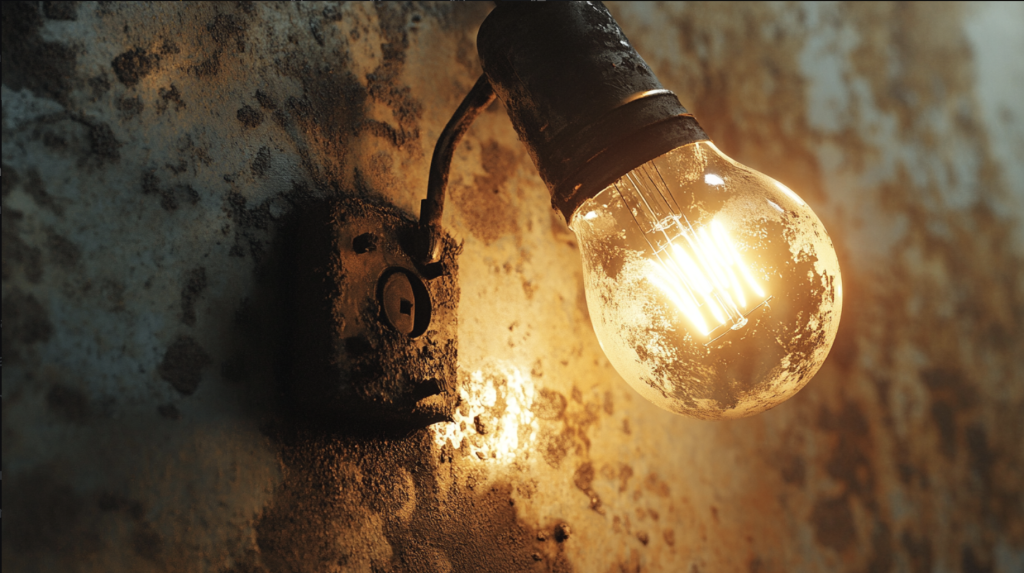
Just like dust can make you sneeze, it can also make your lights flicker.
Over time, dust and debris accumulate in light sockets, interfering with the connection between the bulb and the power source.
- Poor contact: Dust acts as an insulator, preventing full contact between the bulb and socket.
- Intermittent connection: As dust particles shift, they can cause the electrical connection to make and break rapidly.
- Increased resistance: A layer of grime can increase electrical resistance, leading to voltage fluctuations.
Solutions
- Turn off power to the socket at the circuit breaker before cleaning.
- Remove the bulb and gently clean the socket with a dry cloth.
- Use compressed air to blow out any stubborn dust or debris.
- Inspect the socket for any signs of damage or corrosion while cleaning.
- If cleaning doesn’t help, or you notice damage, have an electrician replace the socket.
Regularly cleaning your light fixtures isn’t just about aesthetics – it can help maintain a steady, flicker-free light.
However, always turn off the power before cleaning any electrical components.
9. Old Wires

As homes age, so does their electrical wiring.
Over time, the insulation around wires can break down, and connections can become loose.
This is especially common in houses built before the 1970s.
- Degraded insulation: This can lead to small power leaks, causing inconsistent current flow.
- Loose connections: As wire ends become brittle, they may not hold tight in outlets or junction boxes.
- Increased resistance: Corroded wires resist electricity flow, leading to voltage drops and flickering.
Solutions for Old Wires
- Have a professional electrician inspect your home’s wiring, especially if it’s over 40.
- Look for signs of outdated wiring like aluminum wires or knob-and-tube systems.
- Consider a partial rewire of problematic areas if a full home rewire isn’t feasible.
- Update your electrical panel if it’s not equipped to handle modern power needs.
- Install GFCI outlets in areas where water is present, like kitchens and bathrooms.
If your home is older and you frequently see flickering, it might be time for a wiring check-up.
While it’s a bigger job, updating old wiring stops the flicker and makes your home safer.
10. Main Connection Issues
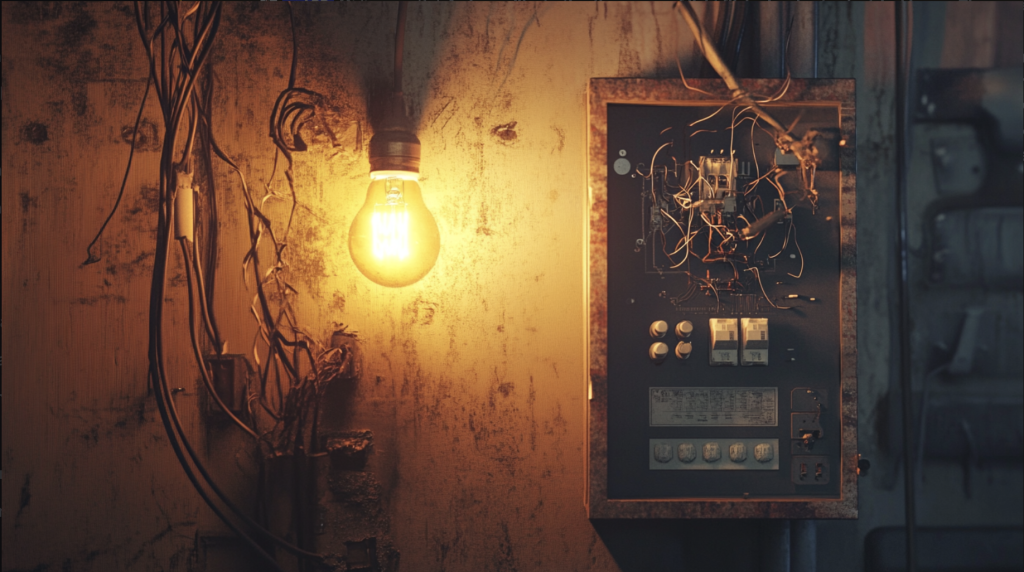
Think of your home’s main electrical connection as the trunk of a tree.
If there’s a problem here, it can affect every branch – or in this case, every circuit in your house.
Main Connection Issues can Include
- Loose connections at the meter box
- Damaged main service cable
- Problems with the utility’s transformer
Solutions for Main Connection Issues
- Contact your utility company to report the issue and request an inspection.
- Have an electrician check your main service panel for loose connections or damage.
- Ensure your home’s grounding system is up to current safety standards.
- Consider installing a whole-house surge protector at your main panel.
- If frequent issues persist, discuss the possibility of upgrading your service capacity with your utility company and an electrician.
These issues can cause voltage fluctuation throughout your home, leading to widespread flickering.
You might notice it’s not just one light but several or all lights flickering simultaneously.
Few Prevention Tips for You
Keeping your lights steady isn’t just about fixing problems but also preventing them.
Here are some simple steps you can take to keep your lights shining bright without any flicker:
Regular Maintenance
- Checking your lights should be part of your home care routine.
- Once a month, go around your house and gently tighten any loose bulbs.
- It’s an easy task that can prevent a lot of flickering issues.
- While at it, wipe down the bulbs and fixtures with a dry cloth to keep them clean and efficient.
Prompt Repairs
- Don’t ignore a switch that feels off.
- If you notice a light switch that’s not clicking properly or feels loose, don’t wait for it to become a bigger problem.
- Replacing a faulty switch is usually a quick and affordable fix that can prevent more serious electrical issues.
Professional Check-Ups
- Just like you get your car serviced, your home’s electrical system needs occasional check-ups, too.
- Consider having an electrician inspect your wiring and voltage every few years, especially if you live in an older home.
- They can spot potential problems before they cause flickering or more serious issues.
Compatibility Checks
- When it’s time to replace a bulb or buy a new lamp, take a moment to check compatibility.
- Ensure you’re using the right bulb type for each fixture, especially with dimmers.
- Using the wrong bulb can lead to flickering and damage to your lights or wiring over time.
Following these simple prevention tips, you can keep your lights steady and your home safe. Remember, a little care goes a long way in maintaining a flicker-free environment!
Conclusion
Flickering lights are more than just an annoyance – they’re often a sign that something’s not quite right in your home’s electrical system.
From loose bulbs to old wiring, we’ve covered ten common causes and their fixes.
While some issues are simple DIY tasks, others require professional help.
Remember, electrical problems can be dangerous if left unchecked.
If you’re dealing with persistent flickering or unsure how to fix an issue safely, don’t hesitate to call in an expert.
Regular maintenance is key to preventing many of these problems.
Check and tighten bulbs as part of your routine, and consider scheduling professional inspections every few years, especially in older homes.
By staying proactive and addressing issues promptly, you can keep your home well-lit, safe, and flicker-free.
Frequently Asked Questions
Why Do My Lights Flicker Intermittently?
Loose bulbs, faulty switches, voltage fluctuations, or wiring issues can cause intermittent flickering. Check the bulb first, and if tightening doesn’t solve the problem, consider other potential causes.
How Can I Fix a Flickering Light Bulb?
First, turn off the light and let it cool. Then, gently tighten the bulb in its socket. If this doesn’t work, try cleaning the bulb base and socket. If flickering persists, the bulb or fixture may need replacement.
Can a Faulty Switch Cause Flickering Lights?
Yes, worn-out switches can cause flickering. If the switch feels loose or doesn’t make a solid ‘click’, it may need replacement. This is usually a job for a professional electrician.
What Should I Do if My Lights Flicker When Large Appliances Turn On?
This often indicates voltage fluctuations. Try spreading high-power appliances across different circuits. If the problem continues, consult an electrician about upgrading your electrical system or installing a voltage stabilizer.
How Can I Tell if My Wiring Is Causing the Flickering?
Wiring might be the culprit if flickering occurs in multiple fixtures or rooms or if you notice other electrical issues like warm outlets or frequent circuit breaker trips. This requires a professional inspection.










